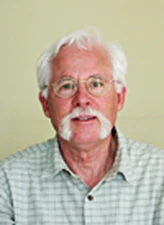Mike J. Kirkby

The 2008 John Dalton Medal is awarded to Mike J. Kirkby for fundamental advances in the theoretical understanding of landscape development.
Professor Mike Kirkby is an eminent researcher who has worked on many different areas of hydrology, soil and landscape development, all concerned with the understanding and modelling of landscape processes and their impact on form. He has had a wide ranging and unprecedented impact on our understandings of network hydrology and landscape development and has influenced and nurtured generations of researchers. He graduated from Cambridge in 1960 with a degree in Geography and Mathematics and remained there to undertake his PhD with Prof. R.J. Chorley, which he completed in 1964. He then moved to the US where he took up research positions with Dr L.B. Leopold and then Prof. W.G. Wolman, before spending a year as a research collaborator at the Smithsonian Institution in Washington DC. In 1965 Mike returned to the UK to undertake a NERC Research Fellowship back at the University of Cambridge. In 1967 he moved to Bristol as a lecturer, then in 1973 moved to be Professor of Physical Geography at the University of Leeds, where he has remained since.
Throughout his work Mike uses models as ‘thought experiments’ which are intended to demonstrate the consistency of general understanding, rather than using models as specific forecasting tools. The main themes of Mike’s research have been i) the detailed understanding of hillslope sediment transport processes, ii) the relationship between hillslope process and form, iii) hillslope and network hydrology, iv) development of peat growth/ hydrological models and v) soil development, landscape and regional scale models. Mike is probably most famous for his work on hillslope and network hydrology which led to contributions in ‘Water, Earth and Man’, and later to publication of the now-standard text ‘Hillslope Hydrology’ (Kirkby, 1976), which has been translated into Russian, Spanish, Chinese and Japanese. Another significant contribution has been providing the theory that underlay the development of the TOPMODEL methodology, especially the concept of the topographic wetness index. The original Beven and Kirkby TOPMODEL paper, with Mike as senior author, is the 3rd most highly cited paper in a hydrology journal. Mike was also key in developing the importance of network hydrology in modelling; the idea of network width function (later generalized to area function) first appeared in a 1976 paper by Mike Kirkby, a few years before the idea of the GIUH concept was introduced. More recently Mike has developed innovative models for peat/mire hydrology and evolution. Recent work has also been concerned with examining the role of partial contributing areas and connectivity in semi-arid areas, particularly in SE Spain.
Over the last decade, further work has focused on the important problems of scaling up models from hillslopes to large catchments and regions. One component of this work is associated with network hydrology, but another, is the effort to simplify our understanding of processes at the hillslope scale, so that their essence is preserved while progressive advances in computing allow the development of effective models for regional areas of interest to both planners and GCM modellers. Many of his ideas are brought together in the classic book ‘Computer Simulation in Physical Geography’ (1986; 1993). Collaborative work with sedimentologists, related to a longer time scale, has created models for the interaction between geomorphology and tectonics. At a coarser spatial scale, some work has also been published on global scale models to provide regional estimates of erodibility, peat growth potential and mass movement hazard. This is relevant to both current global change concerns, and to interpreting the ocean sediment and solute record.
Mike’s work, sustained over many decades, is a classic example of synthesis, long before it becomes an accepted paradigm. He has enriched hydrologic science through cross-fertilization of knowledge and concepts from hydrology, ecology and geomorphology. The use of the topographic index that underpins TOPMODEL, the use of the network width and area functions to characterize catchment storm response, the elegant ideas behind co-evolution of climate, soil, topography and vegetation, and his recent work on hydrologic connectivity are all examples of fundamental advances in hydrology that have been developed from the deep and innovative insights from within Mike’s creative mind.
Mike’s contribution to hydrology and geomorphology has been recognized world wide. In 1976 he was awarded the Gill Memorial award by the Royal Geographical Society; in 1989 the David Linton Award by the British Geomorphological Research Group; in 1999 the Founder’s Medal from the Royal Geographical Society with the Institute of British Geographers and in 2004 he was appointed Fellow of the American Geophysical Union. Mike has convened numerous sessions at major internal conferences, given keynote lectures throughout the world and is committed to communicating his research as widely as possible. We also would like to acknowledge Mike’s generosity to and unselfish support of younger colleagues.
Interview with Mike Kirkby (Vienna, 2018)
As a companion to the History of Hydrology session at European Geosciences Union General Assembly 2018 five interviews were recorded with former John Dalton or Henry Darcy EGU medallists. These interviews serve as an audiovisual recording of the history of hydrology.
This History of Hydrology interview features Professor Mike Kirkby from the University of Leeds, UK, who was the 2008 John Dalton medallist. He is interviewed by Professor Keith Beven of Lancaster University, UK at the Austria Center, Vienna, Austria, 11 April, 2018.
